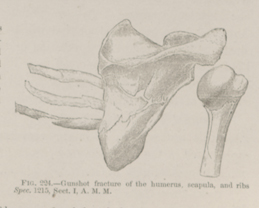Title: L——, Thomas
Source text: Surgeon General Joseph K. Barnes, United States Army, The Medical and Surgical History of the War of the Rebellion. (1861–65.), Part 1, Volume 2 (Washington, D.C.: Government Printing Office, 1870), 485.
Civil War Washington ID: med.d1e19356
TEI/XML: med.d1e19356.xml
Private Thomas L——, Co. K, 1st Massachusetts Volunteers, aged 42 years, having been wounded at Fredericksburg, Virginia, on May 3d, 1863, was sent to Washington, and admitted to Carver Hospital on the 9th. An unknown missile had entered the right shoulder about two inches below the acromion process, and, passing backward and inward, had emerged above the inferior angle of the scapula. The patient's pulse was 120, and quite weak, and his skin was bathed in perspiration. Percussion over the right lung elicited considerable dullness. The treatment consisted in the frequent administration of anodynes, stimulants, and tonics, with a low diet. The patient suffered from anorexia and insomnia, and bloody serum was discharged through the posterior wound during inspiration. Air was also forced through at the same time. He died on the morning of the 11th. The autopsy discovered a fracture at the surgical neck of the humerus; the sixth, seventh, and eighth ribs were comminuted, and portions of bone were forced through the pleura, the cavity of which contained a large quantity of bloody serum. The scapula was also fractured, and the tissues surrounding the wound were much inflamed. The costal surface of the pleura was coated with fibrinous exudations. The pathological specimen, consisting of the right scapula, upper third of the humerus, and sections of the fifth, seventh, and eighth ribs, was contributed by Surgeon O. A. Judson, U. S. V., and is represented in the wood-cut (FIG. 224).
